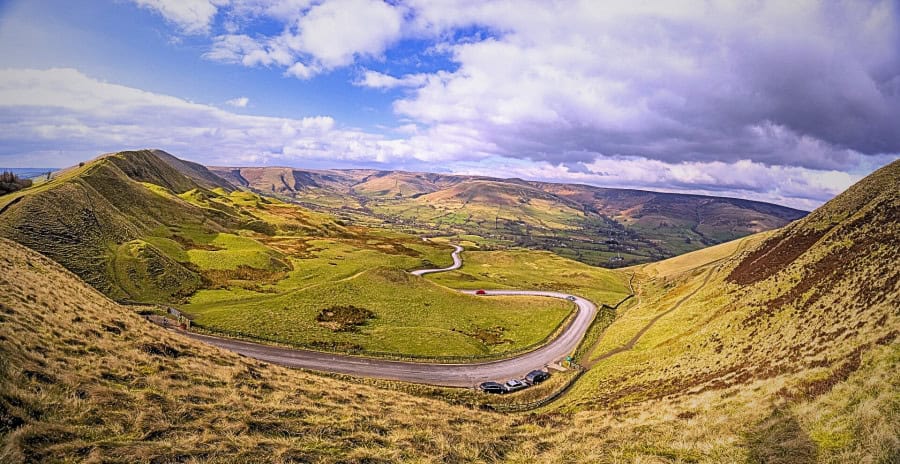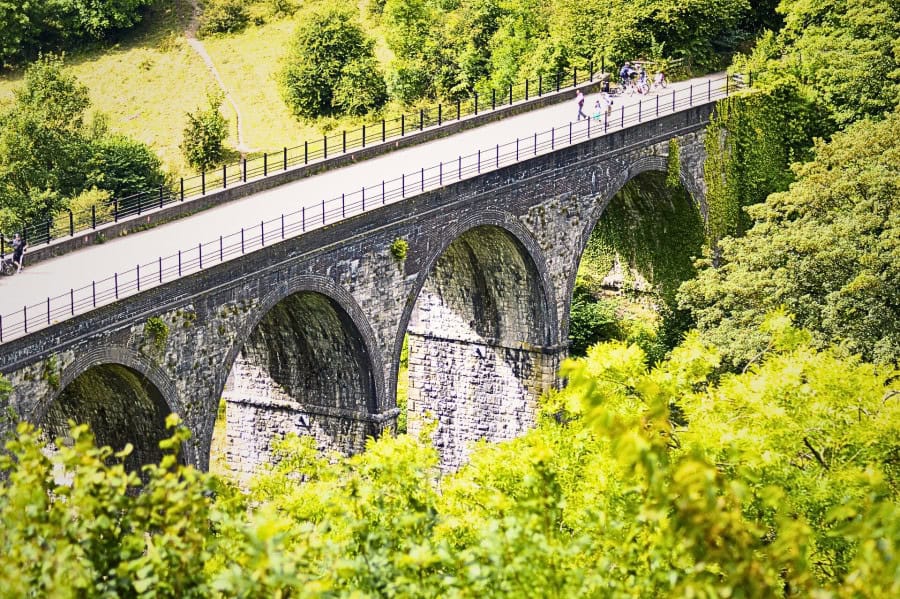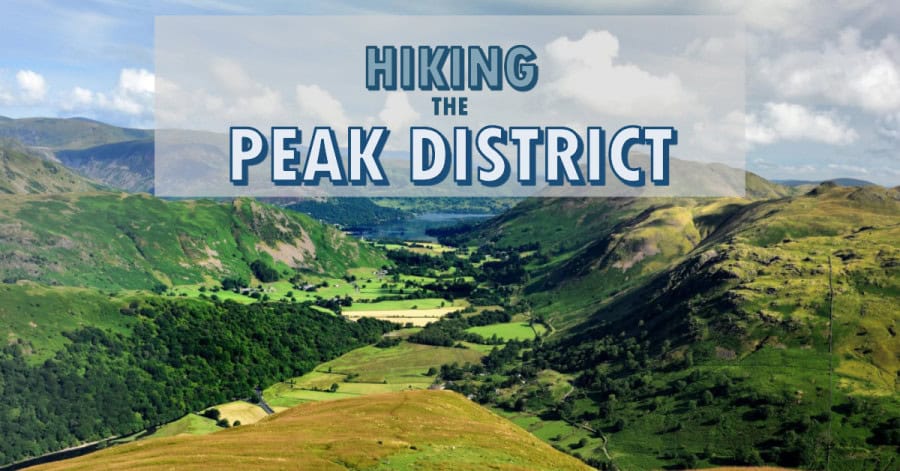Table of Contents
Some links on posts are affiliate links and will earn us a commission from qualifying purchases
Ready for an adventure in the heart of England? The Peak District, an upland area in central-northern England at the southern end of the Pennines, beckons.
This isn’t just any old national park; it’s a place of dramatic landscapes and breathtaking views, drawing in over 13 million visitors every year. As the first National Park designated in the UK back in 1951, the Peak District offers a unique blend of natural beauty and historical significance. (See more about National Parks here).
From its sweeping moorlands and rolling hills to dramatic plateaus, valleys, and limestone gorges plus the striking gritstone escarpments, there’s a landscape for everyone to explorewhilst hiking the Peak District.
Nature and Scenery: Why the Peak District is a Hiker’s Paradise
The Peak District’s diverse landscapes make it one of the most captivating places to hike in the UK. From dramatic gritstone ridges to serene limestone valleys, the natural beauty of this area promises something unique at every turn. Here’s why it stands out:
Iconic Peaks and Edges
- Mam Tor (“The Shivering Mountain”): One of the most celebrated peaks in the district, Mam Tor offers breathtaking panoramic views of the Edale Valley, Hope Valley, and beyond. The layered cliffs of shale and gritstone create a striking visual, particularly during sunrise or sunset, when the light bathes the landscape in warm hues. The summit is easily accessible and perfect for both novice hikers and experienced trekkers.
- Stanage Edge: A must-visit for rock climbers and walkers alike, Stanage Edge stretches for miles and provides awe-inspiring views of the surrounding moorland. The edge is also steeped in history, with remnants of ancient millstones scattered along its paths.
- The Roaches: This gritstone ridge in the South West Peak is known for its dramatic rock formations and lush greenery. It’s home to the mystical “Lud’s Church,” a deep, moss-covered chasm that feels like stepping into another world.

Limestone Valleys and Gorges
- Dovedale: A stunning limestone valley famous for its stepping stones crossing the River Dove. Towering cliffs, crystal-clear streams, and the iconic Thorpe Cloud hill make this area a favorite for families and seasoned hikers alike. Wildlife enthusiasts will appreciate the kingfishers and dippers often spotted along the riverbanks.
- Lathkill Dale: Known for its tranquil atmosphere, Lathkill Dale features cascading waterfalls, limestone cliffs, and rare wildflowers. It’s an excellent spot for a peaceful hike and photography.
Wild Moorlands
- Kinder Scout: The Peak District’s highest point and a rugged adventure. This vast moorland is famous for its peat bogs, dramatic weathered rock formations, and stunning views of the surrounding valleys. The plateau is a challenging but rewarding hike, with landmarks like the Woolpacks and Kinder Downfall – the tallest waterfall in the district, which sometimes flows upward in strong winds.
- Bleaklow and Black Hill: True to their names, these moorlands are remote and atmospheric, offering a sense of wildness. Perfect for hikers seeking solitude, they’re home to rare blanket bog habitats and wide-open skies.
Rivers and Reservoirs
- Ladybower Reservoir: An iconic location surrounded by rolling hills and woodlands. Hikers can enjoy scenic circular walks with views of the reservoir’s dramatic viaducts and sometimes glimpse submerged villages during low water levels.
- Upper Derwent Valley: Known as the “Lake District of the Peak,” this area features the Howden, Derwent, and Ladybower reservoirs, all surrounded by picturesque forest trails and steep climbs for those seeking panoramic vistas.
- River Wye: Flowing through charming limestone valleys, the River Wye is a serene companion on many hikes. Its crystal-clear waters attract a variety of wildlife, including trout and herons.
Seasonal Highlights
- Spring: Watch the Peak District come alive with vibrant wildflowers, including bluebells in the woodlands and orchids in the meadows.
- Summer: The rolling hills are lush and green, with long daylight hours perfect for extended hikes.
- Autumn: The moorlands and woodlands are ablaze with shades of gold, red, and orange, creating a hiker’s dreamscape.
- Winter: Frost-laden landscapes transform the district into a magical setting, with snow-capped peaks and icy rivers adding a unique beauty.
Wildlife and Conservation
The Peak District is home to a variety of wildlife, making it a haven for nature enthusiasts. Birds such as curlews, lapwings, and red grouse can be spotted across the moors. Peregrine falcons nest along the gritstone edges, while dippers and otters thrive in the rivers. The limestone grasslands host rare plants like the purple-flowering Jacob’s ladder and the delicate orchids that flourish in the spring.
The National Park’s conservation efforts have ensured the protection of these habitats, making the Peak District not just a beautiful place to hike but also a vital ecological sanctuary.
Exploring the Landscapes
The Peak District is often divided into three distinct regions, each with its unique character.
The Dark Peak
Imagine largely uninhabited moorland and gritstone escarpments dominating the northern parts and the eastern and western margins. The Dark Peak is characterized by heather moorland and blanket bog, with rough sheep pasture.
Its wild beauty is best embodied by Kinder Scout, the highest point in the Peak District at 2,087 ft (636 m). Hiking Kinder Scout offers a mix of rugged terrain, stunning views, and a sense of isolation perfect for adventurers. Be prepared for more snowfall and frost cover compared to the White Peak.
The White Peak
The White Peak is the limestone heart of the Peak District, renowned for its rolling farmland, picturesque valleys, and striking limestone gorges. This region is home to most of the settlements and provides a more pastoral landscape compared to the rugged Dark Peak.
Popular areas include Dovedale, famous for its stepping stones and the dramatic Thorpe Cloud hill, and Monsal Dale, where the iconic viaduct frames a beautiful scene.
Look out for the unique flora in the White Peak. Calcareous grasslands, ash woodlands, and rock outcrops support a diverse array of plant life. Keep an eye out for rare metallophyte plants on old lead rakes.
South West Peak
The South West Peak offers a tranquil blend of farmland, pastured valleys, and gritstone edges. This lesser-explored region has a quiet charm, with highlights including The Roaches, a gritstone ridge popular with climbers and walkers. The South West Peak is perfect for those seeking solitude and a connection with nature.
Hiking Trails and Routes
The Peak District is a hiker’s paradise, with options ranging from challenging long-distance trails to gentle strolls along former railway lines.
Long-Distance Trails
- The Pennine Way: A legendary 268-mile route starting in Edale, taking hikers through the Dark Peak and beyond. Even tackling just a section of this trail offers an unforgettable experience.
- The Peak District Boundary Walk: A 190-mile circular route around the National Park, offering varied landscapes and a chance to explore lesser-known areas.
Former Railway Lines
The Peak District’s former railway lines have been transformed into accessible trails for walkers, cyclists, and horse riders. These routes are relatively flat and family-friendly:
- Manifold Way: Following the old Leek and Manifold Valley Light Railway, it’s a peaceful trail surrounded by picturesque scenery.
- Tissington Trail: A scenic route starting at Ashbourne and heading north.
- High Peak Trail: Offering stunning views and a glimpse into the area’s industrial heritage.
- Monsal Trail: Famous for its tunnels and breathtaking views of Monsal Dale.
- Longdendale Trail: Part of the Trans Pennine Trail, ideal for walkers and cyclists.

Here’s an article about hiking on railway lines.
Open Access Areas
The Peak District boasts over 1,800 miles of public footpaths, allowing visitors to roam and explore. Many areas are open access, meaning you can wander freely across moorlands and hills. For wheelchair users and families, accessible trails with level paths are available, such as sections of the Monsal Trail and Tissington Trail.
Guided Walks
If you would rather join others whilst hiking the Peak District, you may wish to go on a guided walk. Check out the Peak District National Park website where tyou can book a guided walk with a park ranger. This could turn out to be a great source of learning while you hike, as they have a vast amount of knowledge to impart along the way.
Each walk will have a particular theme, so there’s lenty for everyone. There’s a list by month of walks that you can book onto, so check it out here.
Villages and Towns
Exploring the villages and towns whilst hiking the Peak District adds another layer of charm to your visit:
Bakewell: Famous for its delectable Bakewell pudding, this bustling market town is steeped in history and charm. Stroll along the River Wye, explore the independent shops, and enjoy the weekly market. It’s a lively hub and a great starting point for your adventure hiking the Peak District.
Castleton: Nestled in the Hope Valley, Castleton is famous for its semi-precious Blue John stone and a network of impressive show caves like Peak Cavern and Speedwell Cavern. The dramatic ruins of Peveril Castle overlook the village, making it a picturesque spot steeped in history.
Edale: This small but significant village marks the southern end of the Pennine Way. Surrounded by stunning landscapes, Edale is a favorite starting point for hikers tackling Kinder Scout or the Pennine Way. Its cozy pubs and friendly atmosphere make it an ideal spot for adventurers to rest and recharge.
Hayfield: Sitting at the foot of Kinder Scout, Hayfield is a peaceful village with a vibrant community feel. It’s a perfect base for outdoor enthusiasts looking to explore Kinder Plateau or follow the Kinder Mass Trespass Trail, a historical route with links to the Right to Roam movement.
Eyam: Known as the “Plague Village,” Eyam has a fascinating and poignant history. During the Black Death, villagers chose to isolate themselves to prevent the spread of the disease. Today, you can explore the Eyam Museum, learn about its courageous past, and enjoy scenic walks around this charming village.
Transportation
The Peak District is well-connected, making it accessible by various modes of transport. However, due to its rural nature and popularity, planning ahead is crucial to ensure a smooth journey and minimize delays.
By Car
Driving is one of the most convenient ways to explore whilst hiking the Peak District, especially for reaching remote areas. The main roads through the region include the A57 (Snake Pass), connecting Sheffield and Manchester; the A628 (Woodhead Pass), another trans-Pennine route; and the A6, which links Derby and Buxton. The Cat and Fiddle Road (A537), stretching between Macclesfield and Buxton, is a scenic but challenging drive with sharp bends and steep gradients, making it popular with motorcyclists and drivers seeking adventure. Keep in mind that these roads can get congested during peak times, especially in summer, and snow or ice in winter often causes temporary closures on routes like Snake Pass. Parking can be a challenge in popular areas, so consider arriving early or using designated car parks.
By Train
The Peak District is served by several railway lines, making it possible to reach key towns and villages without a car. The Hope Valley Line is one of the most scenic routes, running between Sheffield and Manchester with stops at Bamford, Hope, Edale, and Hathersage. The Buxton Line connects Manchester with Buxton, while the Derwent Valley Line links Derby to Matlock, providing access to the southern edge of the park. The Glossop Line and Huddersfield Line also serve areas around the northern edge of the Peak District. Trains are frequent, but it’s advisable to check schedules in advance, especially on weekends and bank holidays when services may be reduced.
By Bus and Coach
Buses are a viable option for accessing the Peak District, with regular services connecting surrounding cities and towns to key destinations within the park. Major hubs such as Bakewell, Buxton, and Matlock are served by buses from Derby, Nottingham, Sheffield, and Manchester. Popular services include the Transpeak route, running between Derby and Buxton, and the National Express coach services that stop in Buxton and Matlock. Rural minibuses also operate within the Peak District, offering connections to smaller villages and more remote locations, but these can be infrequent. Be sure to check local bus timetables before planning your journey.
Cycling
Cycling is not only a great way to explore the Peak District but also an environmentally friendly transport option. The region has invested heavily in improving its cycling infrastructure, with miles of dedicated bike paths and converted former railway trails such as the Monsal Trail, Tissington Trail, and High Peak Trail. These routes are ideal for families and less experienced cyclists, offering flat, traffic-free paths with spectacular views. For those who don’t own a bike, there are cycle hire centers in Ashbourne, Bakewell, and Parsley Hay, many of which also provide e-bikes for tackling tougher terrains.
Walking
If you’re already in the area or visiting one of the main towns, walking is often the best way to explore the Peak District’s trails and villages. Many hiking routes start directly from train stations or bus stops, such as the popular paths leading from Edale station into the Dark Peak, or from Matlock station into the White Peak. Plan your walks in advance to make use of public transport links and reduce reliance on cars.
Taxis and Ridesharing
Taxis are available in the larger towns, such as Buxton and Bakewell, but they’re less common in smaller villages. Pre-booking a taxi is recommended, especially during busy seasons or late evenings. Ridesharing services like Uber are not widely available in the Peak District due to its rural nature, so it’s best not to rely on these as your primary means of transport.
Travel Tips
- Check Road and Rail Conditions: Winter weather can affect both road and rail networks, so monitor updates on closures and delays.
- Consider Park-and-Ride Options: To avoid traffic and parking issues, use park-and-ride facilities available in nearby cities and towns.
- Plan for Remote Areas: Some areas of the Peak District have limited public transport options, so make sure to research in advance and have a backup plan.
- Use Local Apps and Resources: Apps like Traveline or the National Rail app can help you navigate schedules and plan your routes efficiently.
By choosing the right transport options, you’ll ensure your Peak District adventure starts and ends without unnecessary stress, leaving more time to soak in the stunning scenery.
Conservation and Responsible Hiking
It’s vital that we all play our part in protecting this beautiful landscape. Footpath users contribute to erosion, especially on the fragile peat moorlands, and mountain bikers can exacerbate this issue. Off-road vehicles can also damage rights of way.
Limestone quarrying, while a part of the local economy, can be contentious, as is the management of the upland moors for driven grouse shooting.
Remember that grasslands have been improved for farming, causing a decline in biodiversity, and the uplands have suffered degradation. So, when you visit, please be mindful of your impact on the environment and follow leave no trace principles.
Planning Your Trip
Timing is everything, right? For most visitors, the sweet spot for exploring is between May and September, when the weather is most favourable. However, the Peak District’s beauty shifts with the seasons. Spring brings a riot of wildflowers, summer offers long daylight hours for extended hikes, autumn is a feast for the eyes with golden hues, and winter’s frost-laden landscapes have a magical charm.
But don’t be fooled into thinking it’s all sunshine and roses! The Peak District, being largely over 1,000 feet above sea level, experiences relatively high rainfall, with the Dark Peak generally getting more than the White Peak. The hills can even see continuous snow cover during some winters, and roads like the A635 (Saddleworth Moor) and A57 (Snake Pass) can be closed due to snow. Always check the weather forecast and road conditions before setting out.
What should you pack? Layers are key to handling the unpredictable weather. A waterproof jacket, sturdy hiking boots, and thermal layers are essential. Don’t forget a map, compass, snacks, and plenty of water. A small first-aid kit and a fully charged phone with a power bank are also wise additions to your gear.
Conclusion – Hiking the Peak District
The Peak District is more than just a beautiful place; it’s a living, breathing landscape with a rich history and diverse ecology. Whether you’re a seasoned hiker or just looking for a weekend getaway, the Peak District offers an unforgettable experience.
So, grab your boots, pack your gear, and come and explore the natural beauty of the Peak District responsibly. Don’t forget to share your own hiking experiences too! For more information, check out the Peak District National Park Authority website and other relevant resources
Recent Posts
The Peak District National Park: a sprawling landscape of rugged beauty, charming villages, and, of course, breathtaking hikes. Whether you're a seasoned hiker or a family looking for a scenic...
The Peak District is a popular destination for hiking enthusiasts due to its stunning landscapes, rolling hills, and picturesque villages. Hiking holidays in the Peak District provide an opportunity...


